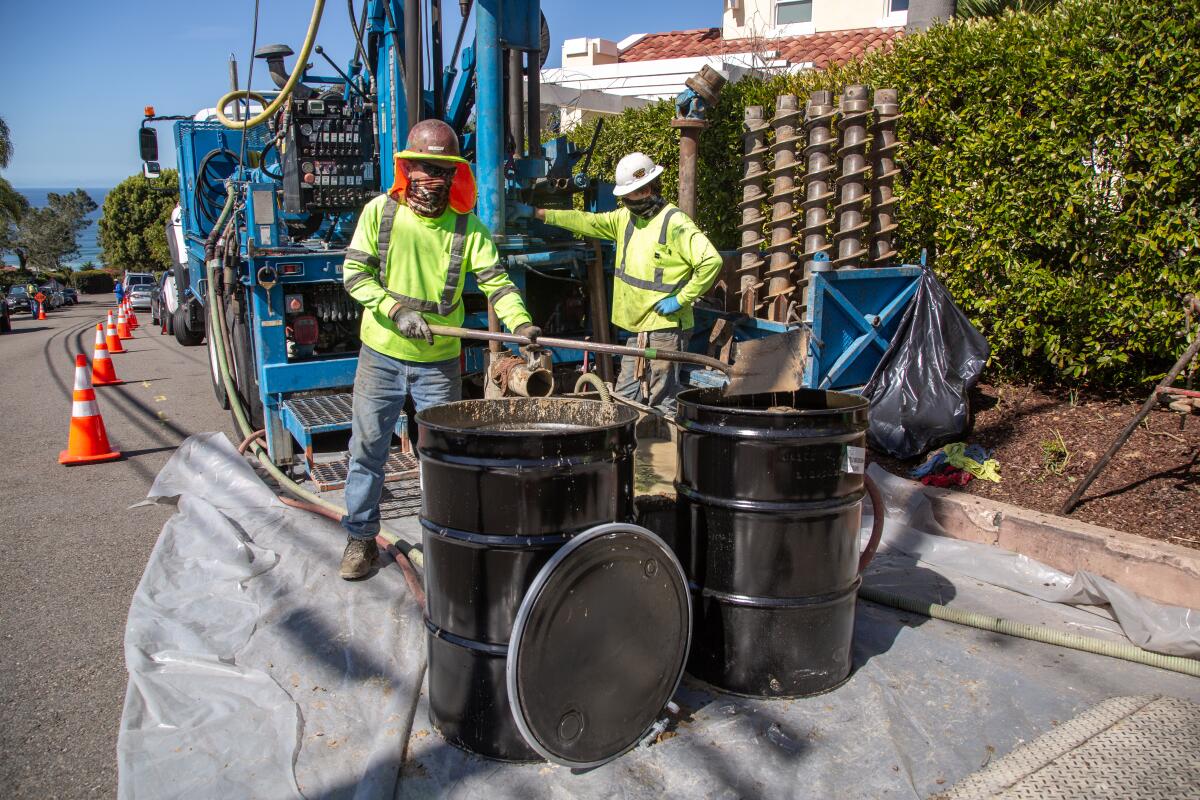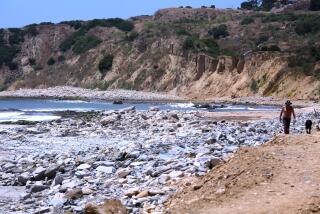Studies underway to find best route for railroad tunnel as San Diego County bluffs crumble

- Share via
DEL MAR, Calif. — A tall blue drilling rig began taking soil samples beneath the hilly streets of Del Mar this month. The foray is part of an operation to eventually move railroad tracks off the crumbling coastal bluffs in this beachfront city in San Diego County.
Five potential inland routes, all involving tunnels or a deep trench beneath the city, have been identified, and the geotechnical investigation underway will help identify the best one, said Linda Culp, a principal planner at the San Diego Assn. of Governments, the regional planning agency.
“We don’t know the particular alignment yet,” Culp said. “This gets us started. This is the first time [for soil samples], but it won’t be the last. We’ll probably come back again and again.”
The proposed new route would replace about 1.7 miles of the railroad installed around 1912 on the steep coastal bluffs. Since then, erosion has been eating away the shoreline at the average rate of 6 inches annually, creeping ever closer to the tracks.
Del Mar residents and city officials have encouraged the governments association and San Diego County’s North County Transit District for years to find a new route.
“A replacement track without severe bends and with double track away from the fragile coastal Del Mar south bluffs is long overdue,” Mayor Terry Gaasterland said by email Thursday.
“It is impossible to safeguard the route without [building] new structures on the bluff,” she said. “Those need to be minimized. Since safety cannot be compromised, that adds even more pressure to select, fund and construct a new route. We need to align federal and state resources quickly to get it done.”
The governments association and the transit district have been working for 20 years on a series of projects to stabilize the tracks where they are. That effort is expected to continue for at least another decade or longer, while the agencies plan, design and build the new route.
In January, workers completed a fourth phase of the stabilization effort. So far, they have added more than 230 concrete-and-steel support columns, extending 60 feet into the ground, along with retaining walls, drainage ditches and other structures, since 2003.
A fifth phase of stabilization work is funded and set to begin in 2023.
The collapse of a large bluff in Del Mar on Feb. 28 near 4th Street, however, showed that two years might be too long to wait. The governments association now plans to speed up some elements of the next phase, such as installing additional support columns and retaining walls, and to do so in the next few months.

The late-February collapse brought the edge of the cliff to within 35 feet of railroad ties at one point, officials said. As a result, rail traffic there is limited to 15 mph for passenger trains and 10 mph for freight trains. The slow spot creates a bottleneck and impedes traffic on the busy coastal rail route, which stretches 351 miles from San Diego to San Luis Obispo.
Transit officials and planners have met daily since the collapse to outline the design, choose a contractor and locate the materials needed for the repairs, said John Haggerty, director of engineering and construction for the San Diego Assn. of Governments.
Preliminary work is planned for March 13 and 14, which is a regularly scheduled weekend suspension of rail service for maintenance and construction. The workers probably will remove some of the loose material remaining at the top of the cliff and take soil samples to help plan construction, Haggerty said Thursday.
Some of the fifth phase of stabilization work probably will be left for 2023, as originally planned, he said.
The sixth and final phase of stabilization work has not been scheduled and is probably several more years away, but that’s intended to keep the tracks safe on the coast until the new inland route is built. Together, the fifth and sixth phases are expected to cost about $100 million.
The long-term goal of the stabilization project has always been to keep the tracks safe until an inland route can be built.
Transit and planning officials have said from the beginning that the route will require tunnels. Construction will cost $3 billion or more and take 10 years. Approval from the various federal and state agencies, including the California Coastal Commission, will take years before construction can start.
Funding is another huge hurdle and is likely to require the passage of a ballot measure. That will take widespread public support and significant political will among local and state elected officials.
“The rail service through Del Mar supports countless jobs and economic activity throughout the region, so it’s critically important that we protect the corridor and develop a new route,” said Rep. Mike Levin (D-San Juan Capistrano), whose district includes Oceanside and the North County Transit District headquarters.
“I was proud to help secure federal funding for bluff stabilization, and as we consider infrastructure legislation in Congress, one of my top priorities is securing additional federal funding to advance the relocation project,” Levin said. “I’ll continue to work with local, state and federal partners to maintain the rail service through this corridor for generations to come.”
Recent collapses have increased the attention on efforts to find a new route. But the search continues at the same steady pace.
The soil tests now underway were scheduled well before the February bluff failure.
Thursday morning, a crew was working in the 400 block of Avenida Primavera, a narrow street with a clear view of the brilliant blue Pacific Ocean in the distance. It was the first of four locations to be tested through March 12, with two to three days at each spot.
The railroad’s new route will be at roughly the same level as the existing tracks, which requires tunneling horizontally beneath the hills of Del Mar. At Thursday’s test site, the deepest samples were taken from about 200 feet, or about the level of the proposed tunnel.
Soil samples will help determine the costs and methods of construction, Haggerty said. The sandy coastal soils that make the bluffs so fragile could aid the excavation and be an advantage for the new route.
“A lot of the cost is based on the tunneling method you would use and how long it would take,” he said.
The new route would have a number of advantages in addition to avoiding the crumbling coast.
Trains could go faster because there are no crossings or other obstacles. The route would be shorter and straighter, which also would reduce travel time.
And a second set of tracks will be built, which will increase the railroad’s capacity and allow trains to pass each other in that area.
About two-thirds of the San Diego County section of the coastal rail corridor has been double-tracked already. But there’s no room for a second set of tracks on the bluffs in Del Mar, and virtually no reason to build it on a site that sooner or later will end up in the ocean.
More to Read
Sign up for Essential California
The most important California stories and recommendations in your inbox every morning.
You may occasionally receive promotional content from the Los Angeles Times.











